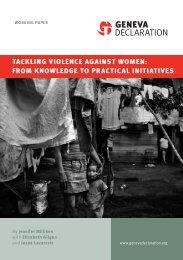Global Burden of Armed Violence - The Geneva Declaration on ...
Global Burden of Armed Violence - The Geneva Declaration on ...
Global Burden of Armed Violence - The Geneva Declaration on ...
You also want an ePaper? Increase the reach of your titles
YUMPU automatically turns print PDFs into web optimized ePapers that Google loves.
Chapter Four Lethal Encounters:<br />
N<strong>on</strong>-c<strong>on</strong>flict <str<strong>on</strong>g>Armed</str<strong>on</strong>g> <str<strong>on</strong>g>Violence</str<strong>on</strong>g><br />
By far the largest aspect <str<strong>on</strong>g>of</str<strong>on</strong>g> the global<br />
burden <str<strong>on</strong>g>of</str<strong>on</strong>g> armed violence is the deaths<br />
and injuries that occur in n<strong>on</strong>-c<strong>on</strong>flict or<br />
n<strong>on</strong>-war settings. Countries such as South Africa,<br />
Jamaica, and El Salvador suffer from extremely<br />
high recorded levels <str<strong>on</strong>g>of</str<strong>on</strong>g> homicide, with more<br />
deaths each year than in many c<strong>on</strong>temporary<br />
wars. This fact al<strong>on</strong>e underlines the importance<br />
<str<strong>on</strong>g>of</str<strong>on</strong>g> adopting a more comprehensive approach to<br />
armed violence, since a narrow focus <strong>on</strong> c<strong>on</strong>flict-<br />
related deaths by development d<strong>on</strong>ors and prac-<br />
titi<strong>on</strong>ers excludes the significant burden <str<strong>on</strong>g>of</str<strong>on</strong>g> armed<br />
violence that occurs in n<strong>on</strong>-c<strong>on</strong>flict settings.<br />
This chapter provides a regi<strong>on</strong>al and subregi<strong>on</strong>al<br />
breakdown <str<strong>on</strong>g>of</str<strong>on</strong>g> the global distributi<strong>on</strong> <str<strong>on</strong>g>of</str<strong>on</strong>g> n<strong>on</strong>-<br />
c<strong>on</strong>flict violent deaths, both in absolute terms<br />
and as rates per 100,000 populati<strong>on</strong>. It also exam-<br />
ines the limited available trend data and provides<br />
informati<strong>on</strong> <strong>on</strong> the burden <str<strong>on</strong>g>of</str<strong>on</strong>g> violence in cities,<br />
firearm homicides, the gendered dimensi<strong>on</strong> <str<strong>on</strong>g>of</str<strong>on</strong>g><br />
violent deaths, and the issue <str<strong>on</strong>g>of</str<strong>on</strong>g> the effectiveness<br />
<str<strong>on</strong>g>of</str<strong>on</strong>g> criminal justice systems.<br />
<str<strong>on</strong>g>The</str<strong>on</strong>g> main findings <str<strong>on</strong>g>of</str<strong>on</strong>g> this chapter are as follows:<br />
Approximately 490,000 deaths from homicide<br />
are estimated to have occurred in 2004. 1 <str<strong>on</strong>g>The</str<strong>on</strong>g><br />
world average homicide rate in 2004 was 7.6<br />
per 100,000 populati<strong>on</strong>.<br />
Southern Africa, Central America, and South<br />
America are the three subregi<strong>on</strong>s with the<br />
highest homicide rates. West and Central<br />
Europe, East Asia, and South-east Europe are<br />
the three subregi<strong>on</strong>s showing the lowest rates<br />
<str<strong>on</strong>g>of</str<strong>on</strong>g> homicide. 2<br />
Approximately 60 per cent <str<strong>on</strong>g>of</str<strong>on</strong>g> all violent deaths<br />
are committed with firearms, with variati<strong>on</strong><br />
from a low <str<strong>on</strong>g>of</str<strong>on</strong>g> 19 per cent in West and Central<br />
Europe to a high <str<strong>on</strong>g>of</str<strong>on</strong>g> 77 per cent in Central<br />
America, based <strong>on</strong> data from 45 countries.<br />
In countries with high homicide rates, women<br />
make up around ten per cent <str<strong>on</strong>g>of</str<strong>on</strong>g> the victims.<br />
As homicide rates drop, women make up a<br />
greater percentage <str<strong>on</strong>g>of</str<strong>on</strong>g> victims, up to around 30<br />
per cent in European countries. Available data<br />
is seldom, however, disaggregated by sex.<br />
Trend data shows few increases in homicide<br />
rates over the past decade. <str<strong>on</strong>g>The</str<strong>on</strong>g> majority <str<strong>on</strong>g>of</str<strong>on</strong>g><br />
subregi<strong>on</strong>s examined show flat or slightly<br />
increasing or decreasing trends. <str<strong>on</strong>g>The</str<strong>on</strong>g>re is little<br />
evidence that armed violence has, at least at<br />
the subregi<strong>on</strong>al level, increased overall in<br />
the Americas, Europe, and Central Asia and<br />
Transcaucasia in recent years.<br />
Arriving at these findings is a complex and delicate<br />
exercise, and the chapter also explains some<br />
<str<strong>on</strong>g>of</str<strong>on</strong>g> the difficulties involved in measuring armed<br />
violence. Existing statistics and data-gathering<br />
mechanisms are underdeveloped, and greater<br />
investment in effective measurement <str<strong>on</strong>g>of</str<strong>on</strong>g> the burden<br />
<str<strong>on</strong>g>of</str<strong>on</strong>g> armed violence will be needed in order to<br />
develop a more accurate picture <str<strong>on</strong>g>of</str<strong>on</strong>g> its overall<br />
scope and impact. 3<br />
67<br />
NON- CO N F L I C T A R M E D V I O L E N C E<br />
1<br />
2<br />
3<br />
4<br />
5<br />
6<br />
7









